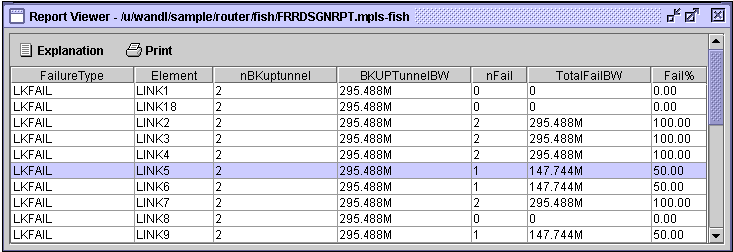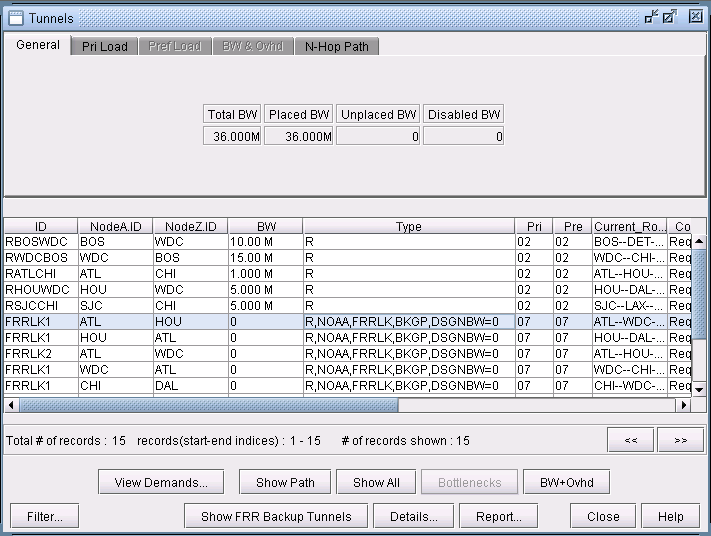- play_arrow Introduction
- play_arrow Router Data Extraction
- play_arrow Routing Protocols
- play_arrow Equal Cost Multiple Paths
- play_arrow Static Routes
- play_arrow Policy-Based Routes
- play_arrow Border Gateway Protocol
- NorthStar Planner Border Gateway Protocol Overview
- Border Gateway Protocol Recommended Instructions
- BGP Data Extraction
- BGP Reports
- BGP Options
- BGP Map
- BGP Live Status Check
- BGP Routing Table
- BGP Routes Analysis
- BGP Information at a Node
- BGP Neighbor
- Apply, Modify, or Add BGP Polices
- BGP Subnets
- Getipconf Usage Notes
- BGP Report
- play_arrow Virtual Private Networks
- NorthStar Planner Virtual Private Networks Overview
- Importing VPN Information from Router Configuration Files
- Viewing the Integrity Checks Reports
- Accessing VPN Summary Information
- Accessing Detailed Information for a Particular VPN
- VPN Topology View
- Route-Target Export/Import Relationships
- Additional Methods to Access VPN Information
- VPN Path Tracing
- VPN Design and Modeling Using the VPN Wizard
- L3 (Layer 3) VPN
- L3 Hub-and-Spoke VPN
- L2M (Layer2-Martini) VPN
- L2K (Layer2-Kompella) VPN
- VPLS-BGP VPN (for Juniper)
- VPLS-LDP VPN
- L2CCC (Circuit Cross-Connect) VPN
- Inter-AS VPN
- Forming VPN Customer Groups
- Deleting or Renaming VPNs
- VPN Configlet Generation
- Adding Traffic Demands in a VPN
- VPN Traffic Generation
- VPN-Related Reports
- VPN Monitoring and Diagnostics
- play_arrow GRE Tunnels
- play_arrow Multicast
- NorthStar Planner Multicast Overview
- NorthStar Planner Recommended Multicast Instructions
- Creating Multicast Groups
- Creating Multicast Demands
- Viewing Multicast Demands in the Network
- Comparing Multicast with Unicast
- Multicast SPT Threshold
- Multicast Reports
- Multicast Simulation
- Collecting Multicast Path Data from Live Network
- Importing Multicast Path Data
- Multicast Data Processing
- Viewing Multicast Trees
- play_arrow Class of Service
- NorthStar Planner Class of Service Overview
- NorthStar Planner Recommended CoS Instructions
- The QoS Manager
- Define Class Maps
- Create Policies for Classes
- Attach Policies to Interfaces
- Adding Traffic Inputs
- Using the Text Editor
- Reporting Module
- IP Flow Information
- Link information
- Traffic Load Analysis
- Traffic Load by Policy Class
- CoS Alias File
- Bblink File
- Policymap File
- Demand File
- Traffic Load File
- play_arrow Routing Instances
- play_arrow Traffic Matrix Solver
- play_arrow LSP Tunnels
- NorthStar Planner LSP Tunnels Overview
- Viewing Tunnel Info
- Viewing Primary and Backup Paths
- Viewing Tunnel Utilization Information from the Topology Map
- Viewing Tunnels Through a Link
- Viewing Demands Through a Tunnel
- Viewing Link Attributes/Admin-Group
- Viewing Tunnel-Related Reports
- Adding Primary Tunnels
- Adding Multiple Tunnels
- Mark MPLS-Enabled on Links Along Path
- Modifying Tunnels
- Path Configuration
- Specifying a Dynamic Path
- Specifying Alternate Routes, Secondary and Backup Tunnels
- Adding and Assigning Tunnel ID Groups
- Making Specifications for Fast Reroute
- Specifying Tunnel Constraints (Affinity/Mask or Include/Exclude)
- Adding One-Hop Tunnels
- Tunnel Layer and Layer 3 Routing Interaction
- play_arrow Optimizing Tunnel Paths
- play_arrow Tunnel Sizing and Demand Sizing
- play_arrow Tunnel Path Design
- Tunnel Path Design Overview
- Tunnel Path Design Instructions
- Designing Tunnel Paths Overview
- Backup Path Configuration Options
- Default Diversity Level
- Evaluate/Tune Options
- Advanced Options
- Viewing Design Results
- Tunnel Modifications
- Exporting and Importing Diverse Group Definitions
- Advanced Path Modification
- play_arrow Inter-Area MPLS-TE
- play_arrow Point-to-Multipoint (P2MP) Traffic Engineering
- NorthStar Planner P2MP Traffic Engineering Overview
- Point-to-Multipoint Traffic Engineering Instructions
- Import a Network That Already has Configured P2MP LSP Tunnels
- Examine the P2MP LSP Tunnels
- Create P2MP LSP Tunnels and Generate Corresponding LSP Configlets
- Examine P2MP LSP Tunnel Link Utilization
- Perform Failure Simulation and Assess the Impact
- play_arrow Diverse Multicast Tree Design
- Diverse Multicast Tree Design Overview
- Diverse Multicast Tree Instructions
- Open a Network That Already Has a Multicast Tree
- Set the Two P2MP Trees of Interest to be in the Same Diversity Group
- Using the Multicast Tree Design Feature to Design Diverse Multicast Trees
- Using the Multicast Tree Design Feature
- play_arrow DiffServ Traffic Engineering Tunnels
- DiffServ Traffic Engineering Tunnels Overview
- Using DS-TE LSP
- Hardware Support for DS-TE LSP
- NorthStar Planner Support for DS-TE LSP
- Configuring the Bandwidth Model and Default Bandwidth Partitions
- Forwarding Class to Class Type Mapping
- Link Bandwidth Reservation
- Creating a New Multi-Class or Single-Class LSP
- Configuring a DiffServ-Aware LSP
- Tunnel Routing
- Link Utilization Analysis
- play_arrow Cisco Auto-Tunnels
- play_arrow Integrity Check Report
- play_arrow Compliance Assessment Tool
- Compliance Assessment Tool Overview
- Using The Compliance Assessment Tool
- CAT Testcase Design
- Creating a New Project
- Loading the Configuration Files
- Creating Conformance Templates
- Reviewing and Saving the Template
- Saving and Loading Projects
- Run Compliance Assessment Check
- Compliance Assessment Results
- Publishing Templates
- Running External Compliance Assessment Scripts
- Scheduling Configuration Checking in Task Manager
- Building Templates
- Special Built-In Functions
- Paragon Planner Keywords For Use Within a Rule
- More on Regular Expressions
- IP Manipulation
- play_arrow Virtual Local Area Networks
- play_arrow Overhead Calculation
- play_arrow Router Reference
FRR Auto Design
When the FRR Design parameters are submitted for Auto Design, the program will automatically create backup tunnels as follows:
If the Protection Type is set to Link, then FRR Auto Design will automatically design the FRR-LP backup tunnels necessary to protect (1) Links along the paths of LSP tunnels requesting FRR protection, and (2) Individual links that have been marked to request FRR protection.
If the Protection Type is set to Node, then FRR Auto Design will automatically design the FRR-NP backup tunnels necessary to protect (1) Nodes along the paths of LSP tunnels requesting FRR protection (excluding the source and destination nodes) and (2) The destination node of links that have been marked to request FRR protection.
Note:When selecting either Node Protection or Link Protection, the Auto Design will automatically enable FRR for all the links along the paths of LSP tunnels requesting FRR protection. If this is not desired, users should use tuning instead of auto design, or in the case of Juniper, select “Auto Bypass” as described below.
If the Design Bandwidth Reference Bandwidth Source is set to Sub-Pool (for Cisco only) then only the links that(1) require FRR protection and (2) have subpool bandwidth allocated will be considered for protection in FRR Auto Design.
If the Protection Type is set to Auto Bypass (for Juniper bypass creation), then FRR Auto Design will automatically design the bypass tunnels for Juniper for FRR-enabled links along the paths of FRR-enabled LSP tunnels. After selecting this option, you will be prompted with the option to design paths using (a) the RSVP signaling bandwidth as the Design Bandwidth or (b) the Backup bandwidth as the Design Bandwidth. Select option (a) if you wish to simulate Juniper’s auto bypass generation. Select option (b) to help ensure there is enough bandwidth on the backup tunnel to protect the primary tunnels.
Note:The Auto Bypass Protection type will preserve the link’s FRR settings and avoid creating backup tunnels for links not enabled for FRR.
Please read through the explanations of the Design options in the previous section carefully for a complete description of each of the FRR Design options. Though the design options may initially appear complex, understanding the function of each option will provide you with enormous flexibility. Once you have specified the desired properties in the FRR Design window, click the “AUTO Design” button.
If you already have some existing fast reroute tunnels in the network, you may also see the following confirmation windows: “Routes and bandwidth for all FRR link protection backup tunnels will be adjusted. Continue?” or “Remove configured paths for 10 FRR link backup tunnels?”
In the Console window, the number of placed/unplaced/deactivated paths for the new tunnels will be displayed. You should see something similar to this:
Diversity Level= SITE Tunnel Site+Link-Diversity Link-Diversity No-Diversity Notplaced Deactivated FRRBackup 10 0 0 0 0
FRR Design Report
When the design is completed, you will be asked whether you wish to view the FRR design report. The report is saved as FRRDSGNRPT.runcode in your File Manager Output Path. To view this report at a later time, right-click on the report in the File Manager and choose Open in Report Viewer from the popup menu.
To see the FRRDSGNRPT report listed in the File Manager, you may need to refresh the File Manager contents first, either by pressing the “Refresh” button or alternatively, the <F5> key.

After the Auto Design has been performed and FRR backup tunnels created, the FRR Design Report displays the result of failing each FRR-protected link or node. For example, in Figure 360, the highlighted table entry indicates that when LINK5 is failed, there are two FRR-LP backup tunnels protecting the link. The total bandwidth of these two backup tunnels is 295.488Mbps. Of these two, one failed to be placed during the link failure. The total bandwidth of this failed backup tunnel is 147.744Mbps, accounting for 50% of the total backup tunnel bandwidth.
FRR Design Report Fields
FailureType: Possible values are LKFAIL, NODEFAIL, and FACFAIL, indicating link, node or facility failure.
If the Link Diversity Level was specified for the Auto Design, then the program will take down each node/link individually and try to find a route that is both site-diverse and link-diverse. If there is none, it will try to find a link-diverse route.
If the Site Diversity Level was specified for the Auto Design, then the program will take down each node/link individually and try to find a site-diverse route. If there is none, it will try to find a link-diverse route. The rationale is that even if site diversity is not met, a link-diverse route is better than no route at all.
If the Facility Diversity Level was specified for the Auto Design, then the program will take down each node/link individually and try to find a route that is both facility-diverse and site-diverse. If there is none, it will try to find a link-diverse route.
Element: Indicates the failed element. If Node Protection Type (or Link Protection Type) was specified for the Auto Design, then all nodes (or all the links) in the network will be failed and brought back up one at a time.
nBKuptunnel: Indicates the number of FRR backup tunnels that are routed through the network Element.
BKUPTunnelBW: Indicates the total backup bandwidth of all the FRR backup tunnels protecting the failed element.
nFail: Indicates the number of backup tunnels that failed to be placed during the element failure.
TotalFailBW: Indicates the total bandwidth of the backup tunnels that failed to be placed during the element failure.
Fail%: Indicates the percentage of backup tunnel bandwidth that failed to be placed during the element failure.
View Created FRR Backup Tunnels
To view the newly designed FRR backup tunnels, select Network > Elements > Tunnels to display all LSP tunnels in the network. Notice that the Type field will indicate whether the FRR backup tunnels are for Link Protection (“FRRLK”) or Node Protection (“FRRND”) and that the No Autoroute Announce flag (“NOAA”) is automatically turned on.
Other possible type fields (for Cisco) are “BKSP” or “BKGP”, indicating that the backup tunnel carries Sub-Pool or Global-Pool tunnels, respectively; this corresponds to the user’s settings of the Protected Tunnel Type field in the FRR Design parameters.

You can further examine the FRR backup tunnels created from the View/Tune Paths window as described in Viewing Primary Tunnels Protected by a Bypass Tunnel.




















